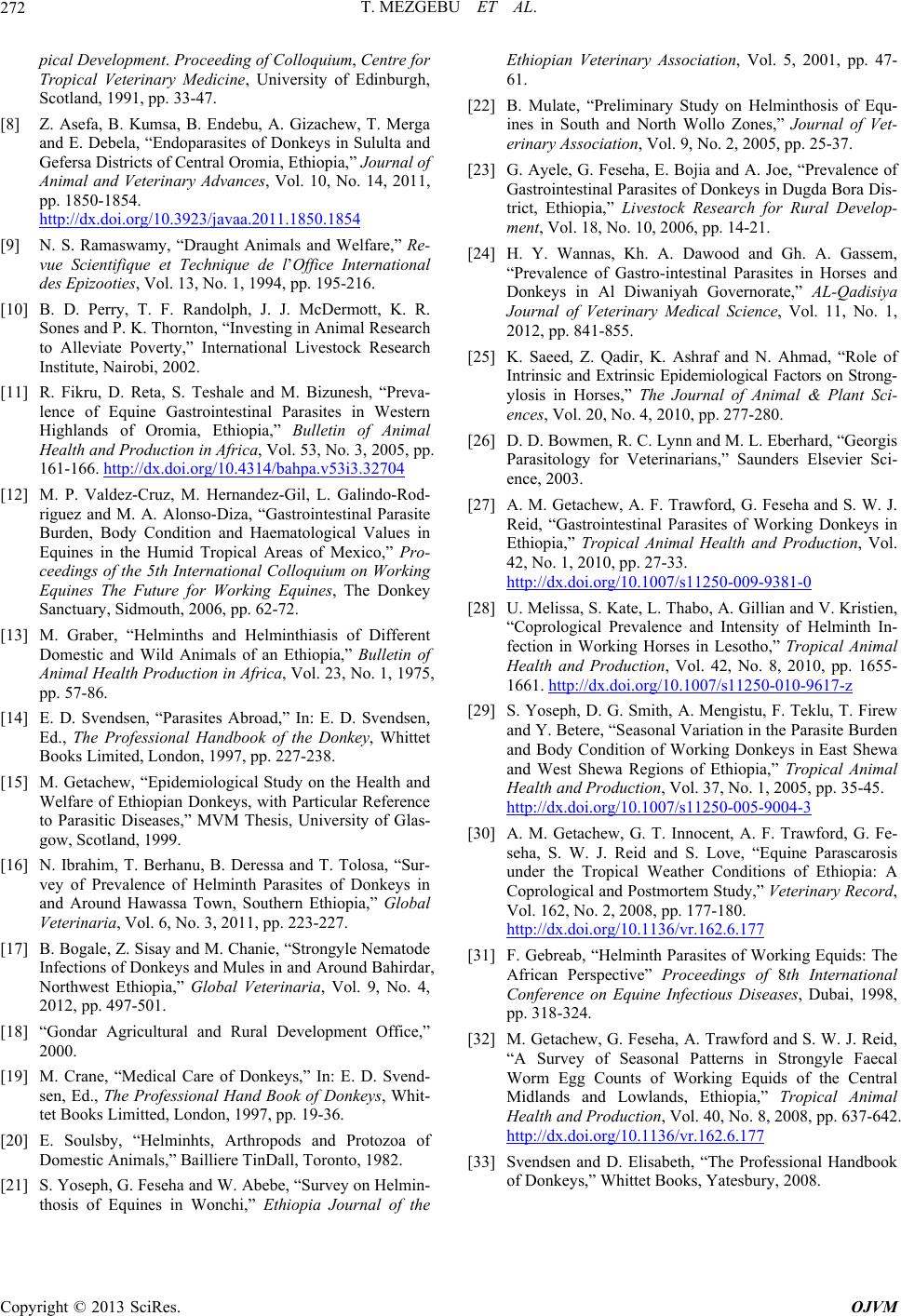
T. MEZGEBU ET AL.
Copyright © 2013 SciRes. OJVM
272
pical Development. Proceeding of Colloquium, Centre for
Tropical Veterinary Medicine, University of Edinburgh,
Scotland, 1991, pp. 33-47.
[8] Z. Asefa, B. Kumsa, B. Endebu, A. Gizachew, T. Merga
and E. Debela, “Endoparasites of Donkeys in Sululta and
Gefersa Districts of Central Oromia, Ethiopia,” Journal of
Animal and Veterinary Advances, Vol. 10, No. 14, 2011,
pp. 1850-1854.
http://dx.doi.org/10.3923/javaa.2011.1850.1854
[9] N. S. Ramaswamy, “Draught Animals and Welfare,” Re-
vue Scientifique et Technique de l’Office International
des Epizooties, Vol. 13, No. 1, 1994, pp. 195-216.
[10] B. D. Perry, T. F. Randolph, J. J. McDermott, K. R.
Sones and P. K. Thornton, “Investing in Animal Research
to Alleviate Poverty,” International Livestock Research
Institute, Nairobi, 2002.
[11] R. Fikru, D. Reta, S. Teshale and M. Bizunesh, “Preva-
lence of Equine Gastrointestinal Parasites in Western
Highlands of Oromia, Ethiopia,” Bulletin of Animal
Health and Production in Africa, Vol. 53, No. 3, 2005, pp.
161-166. http://dx.doi.org/10.4314/bahpa.v53i3.32704
[12] M. P. Valdez-Cruz, M. Hernandez-Gil, L. Galindo-Rod-
riguez and M. A. Alonso-Diza, “Gastrointestinal Parasite
Burden, Body Condition and Haematological Values in
Equines in the Humid Tropical Areas of Mexico,” Pro-
ceedings of the 5th International Colloquium on Working
Equines The Future for Working Equines, The Donkey
Sanctuary, Sidmouth, 2006, pp. 62-72.
[13] M. Graber, “Helminths and Helminthiasis of Different
Domestic and Wild Animals of an Ethiopia,” Bulletin of
Animal Health Production in Africa, Vol. 23, No. 1, 1975,
pp. 57-86.
[14] E. D. Svendsen, “Parasites Abroad,” In: E. D. Svendsen,
Ed., The Professional Handbook of the Donkey, Whittet
Books Limited, London, 1997, pp. 227-238.
[15] M. Getachew, “Epidemiological Study on the Health and
Welfare of Ethiopian Donkeys, with Particular Reference
to Parasitic Diseases,” MVM Thesis, University of Glas-
gow, Scotland, 1999.
[16] N. Ibrahim, T. Berhanu, B. Deressa and T. Tolosa, “Sur-
vey of Prevalence of Helminth Parasites of Donkeys in
and Around Hawassa Town, Southern Ethiopia,” Global
Veterinaria, Vol. 6, No. 3, 2011, pp. 223-227.
[17] B. Bogale, Z. Sisay and M. Chanie, “Strongyle Nematode
Infections of Donkeys and Mules in and Around Bahirdar,
Northwest Ethiopia,” Global Veterinaria, Vol. 9, No. 4,
2012, pp. 497-501.
[18] “Gondar Agricultural and Rural Development Office,”
2000.
[19] M. Crane, “Medical Care of Donkeys,” In: E. D. Svend-
sen, Ed., The Professional Hand Book of Donkeys, Whit-
tet Books Limitted, London, 1997, pp. 19-36.
[20] E. Soulsby, “Helminhts, Arthropods and Protozoa of
Domestic Animals,” Bailliere TinDall, Toronto, 1982.
[21] S. Yoseph, G. Feseha and W. Abebe, “Survey on Helmin-
thosis of Equines in Wonchi,” Ethiopia Journal of the
Ethiopian Veterinary Association, Vol. 5, 2001, pp. 47-
61.
[22] B. Mulate, “Preliminary Study on Helminthosis of Equ-
ines in South and North Wollo Zones,” Journal of Vet-
erinary Association, Vol. 9, No. 2, 2005, pp. 25-37.
[23] G. Ayele, G. Feseha, E. Bojia and A. Joe, “Prevalence of
Gastrointestinal Parasites of Donkeys in Dugda Bora Dis-
trict, Ethiopia,” Livestock Research for Rural Develop-
ment, Vol. 18, No. 10, 2006, pp. 14-21.
[24] H. Y. Wannas, Kh. A. Dawood and Gh. A. Gassem,
“Prevalence of Gastro-intestinal Parasites in Horses and
Donkeys in Al Diwaniyah Governorate,” AL-Qadisiya
Journal of Veterinary Medical Science, Vol. 11, No. 1,
2012, pp. 841-855.
[25] K. Saeed, Z. Qadir, K. Ashraf and N. Ahmad, “Role of
Intrinsic and Extrinsic Epidemiological Factors on Strong-
ylosis in Horses,” The Journal of Animal & Plant Sci-
ences, Vol. 20, No. 4, 2010, pp. 277-280.
[26] D. D. Bowmen, R. C. Lynn and M. L. Eberhard, “Georgis
Parasitology for Veterinarians,” Saunders Elsevier Sci-
ence, 2003.
[27] A. M. Getachew, A. F. Trawford, G. Feseha and S. W. J.
Reid, “Gastrointestinal Parasites of Working Donkeys in
Ethiopia,” Tropical Animal Health and Production, Vol.
42, No. 1, 2010, pp. 27-33.
http://dx.doi.org/10.1007/s11250-009-9381-0
[28] U. Melissa, S. Kate, L. Thabo, A. Gillian and V. Kristien,
“Coprological Prevalence and Intensity of Helminth In-
fection in Working Horses in Lesotho,” Tropical Animal
Health and Production, Vol. 42, No. 8, 2010, pp. 1655-
1661. http://dx.doi.org/10.1007/s11250-010-9617-z
[29] S. Yoseph, D. G. Smith, A. Mengistu, F. Teklu, T. Firew
and Y. Betere, “Seasonal Variation in the Parasite Burden
and Body Condition of Working Donkeys in East Shewa
and West Shewa Regions of Ethiopia,” Tropical Animal
Health and Production, Vol. 37, No. 1, 2005, pp. 35-45.
http://dx.doi.org/10.1007/s11250-005-9004-3
[30] A. M. Getachew, G. T. Innocent, A. F. Trawford, G. Fe-
seha, S. W. J. Reid and S. Love, “Equine Parascarosis
under the Tropical Weather Conditions of Ethiopia: A
Coprological and Postmortem Study,” Veterinary Record,
Vol. 162, No. 2, 2008, pp. 177-180.
http://dx.doi.org/10.1136/vr.162.6.177
[31] F. Gebreab, “Helminth Parasites of Working Equids: The
African Perspective” Proceedings of 8th International
Conference on Equine Infectious Diseases, Dubai, 1998,
pp. 318-324.
[32] M. Getachew, G. Feseha, A. Trawford and S. W. J. Reid,
“A Survey of Seasonal Patterns in Strongyle Faecal
Worm Egg Counts of Working Equids of the Central
Midlands and Lowlands, Ethiopia,” Tropical Animal
Health and Production, Vol. 40, No. 8, 2008, pp. 637-642.
http://dx.doi.org/10.1136/vr.162.6.177
[33] Svendsen and D. Elisabeth, “The Professional Handbook
of Donkeys,” Whittet Books, Yatesbury, 2008.